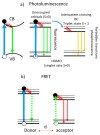Raman and Fluorescence Enhancement Approaches in Graphene-Based Platforms for Optical Sensing and Imaging
- PMID: 33808013
- PMCID: PMC7999291
- DOI: 10.3390/nano11030644
Raman and Fluorescence Enhancement Approaches in Graphene-Based Platforms for Optical Sensing and Imaging
Abstract
The search for novel platforms and metamaterials for the enhancement of optical and particularly Raman signals is still an objective since optical techniques offer affordable, noninvasive methods with high spatial resolution and penetration depth adequate to detect and image a large variety of systems, from 2D materials to molecules in complex media and tissues. Definitely, plasmonic materials produce the most efficient enhancement through the surface-enhanced Raman scattering (SERS) process, allowing single-molecule detection, and are the most studied ones. Here we focus on less explored aspects of SERS such as the role of the inter-nanoparticle (NP) distance and the ultra-small NP size limit (down to a few nm) and on novel approaches involving graphene and graphene-related materials. The issues on reproducibility and homogeneity for the quantification of the probe molecules will also be discussed. Other light enhancement mechanisms, in particular resonant and interference Raman scatterings, as well as the platforms that allow combining several of them, are presented in this review with a special focus on the possibilities that graphene offers for the design and fabrication of novel architectures. Recent fluorescence enhancement platforms and strategies, so important for bio-detection and imaging, are reviewed as well as the relevance of graphene oxide and graphene/carbon nanodots in the field.
Keywords: FRET; SERS; enhanced Raman scattering; enhanced fluorescence; graphene; graphene nanodots; interference; nanoparticles; optical simulations; plasmonics; resonant Raman scattering.
Conflict of interest statement
The authors declare no conflict of interest. The funders had no role in the design of the study; in the collection, analyses, or interpretation of data; in the writing of the manuscript, or in the decision to publish the results.
Figures


















Similar articles
-
Supported Ultra-Thin Alumina Membranes with Graphene as Efficient Interference Enhanced Raman Scattering Platforms for Sensing.Nanomaterials (Basel). 2020 Apr 27;10(5):830. doi: 10.3390/nano10050830. Nanomaterials (Basel). 2020. PMID: 32349274 Free PMC article.
-
Efficient Heterostructures for Combined Interference and Plasmon Resonance Raman Amplification.ACS Appl Mater Interfaces. 2017 Feb 1;9(4):4119-4125. doi: 10.1021/acsami.6b12490. Epub 2017 Jan 18. ACS Appl Mater Interfaces. 2017. PMID: 28054769
-
Dual-Enhanced Raman Scattering-Based Characterization of Stem Cell Differentiation Using Graphene-Plasmonic Hybrid Nanoarray.Nano Lett. 2019 Nov 13;19(11):8138-8148. doi: 10.1021/acs.nanolett.9b03402. Epub 2019 Nov 1. Nano Lett. 2019. PMID: 31663759
-
Chemical and Bio Sensing Using Graphene-Enhanced Raman Spectroscopy.Nanomaterials (Basel). 2019 Apr 2;9(4):516. doi: 10.3390/nano9040516. Nanomaterials (Basel). 2019. PMID: 30986978 Free PMC article. Review.
-
Lighting up the Raman signal of molecules in the vicinity of graphene related materials.Acc Chem Res. 2015 Jul 21;48(7):1862-70. doi: 10.1021/ar500466u. Epub 2015 Jun 9. Acc Chem Res. 2015. PMID: 26056861 Review.
Cited by
-
Fluorescence Based Trace Level Detection of Cobalt Using 2,6-bis((E)-4-chlorobenzylidene)-4-methylcyclohexan-1-one as Sensor.J Fluoresc. 2025 Apr 23. doi: 10.1007/s10895-025-04306-x. Online ahead of print. J Fluoresc. 2025. PMID: 40266481
-
Advances in the application of Raman spectroscopy in haematological tumours.Front Bioeng Biotechnol. 2023 Jan 10;10:1103785. doi: 10.3389/fbioe.2022.1103785. eCollection 2022. Front Bioeng Biotechnol. 2023. PMID: 36704299 Free PMC article. Review.
-
One-Step Homogeneous Immunoassay for the Detection of Influenza Virus Using Switching Peptide and Graphene Quencher.Biochip J. 2022;16(3):334-341. doi: 10.1007/s13206-022-00076-x. Epub 2022 Jul 27. Biochip J. 2022. PMID: 35909466 Free PMC article.
References
-
- Wilson W.D. A technique whose time has come. Sci. Tech. Sight. 2002;295:64–65.
-
- Grant Albercht M., Alan Creighton J. Anomalously intense Raman spectra of pyridine at a silver electrode. J. Am. Chem. Soc. 1977;99:5215–5217. doi: 10.1021/ja00457a071. - DOI
-
- Sharma B., Frontiera R.R., Henry A.-I., Ringe E., Van Duyne R.P. SERS: Materials, Applications, and the Future. Mater. Today. 2012;15:16–25. doi: 10.1016/S1369-7021(12)70017-2. - DOI
Publication types
Grants and funding
LinkOut - more resources
Full Text Sources
Other Literature Sources
Miscellaneous

